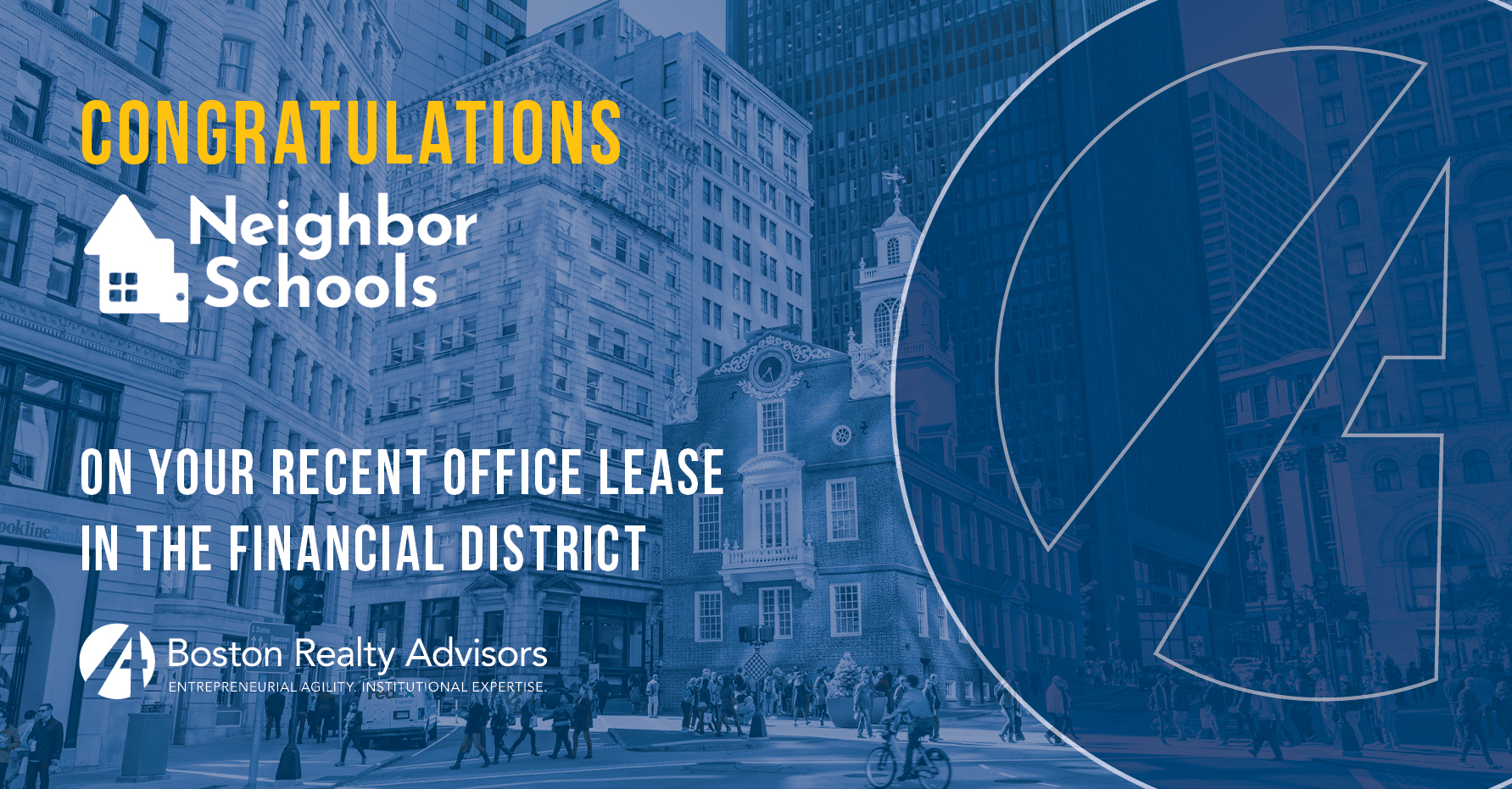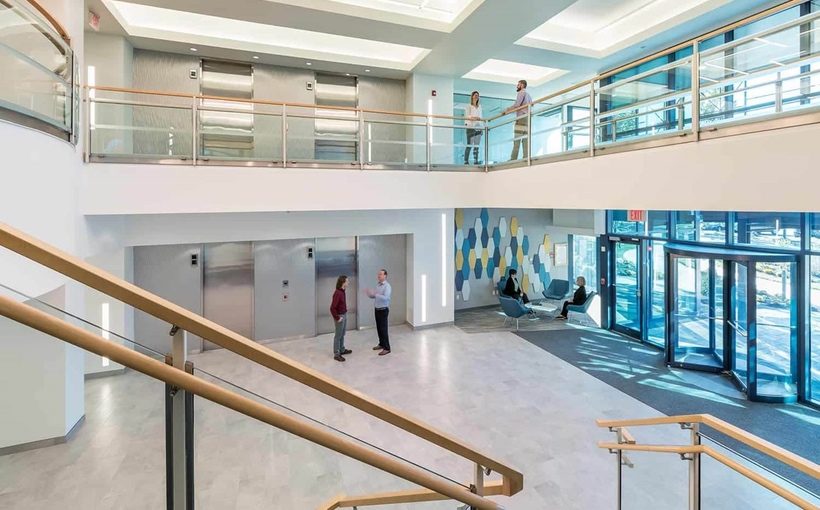
Monthly Archives: February 2020
0 “The Providers” Expands in Framingham Relocation

By Connect Boston | February 25, 2020
The Massachusetts Council of Human Service Providers, a/k/a “The Providers,” relocated from Boston and signed a new long-term lease for more than 7,000 square feet at National Development’s 100 Crossing Boulevard in Framingham, MA. The Providers relocated from 4,200 square feet at 88 Broad St.
The Providers selected 100 Crossing Boulevard in part because of its proximity to Routes 90, 93 and 9, providing employee and client access to the space for training and daily administration of the firm. National Development worked with Margulies Perruzzi Architects and Boston Realty Advisors (BRA) to replace the former Cumberland Farms headquarters with a custom-build experience.
BRA’s Chris McMahon represented The Providers, and the landlord was advised by Cushman & Wakefield.
0 Boston Realty Advisors Congratulates iContour Anti-Aging Center on Office Lease in Back Bay
![]()
0 Boston Realty Brings Cambridge Mixed-Use to Market
 By Connect Boston | February 24, 2020
By Connect Boston | February 24, 2020
A rare trophy mixed-use co-op property in Cambridge, 872 Massachusetts Ave., has been brought to the sales market courtesy of Boston Realty Advisors (BRA). The firm’s Jason S. Weissman, Nicholas M. Herz, Kevin R. Benzinger and Andrew B. Herald are scheduling tours, with a “call for offers” to follow.
Located within minutes of Kendall Square—said to be the world’s largest hub of life sciences and technology companies–and situated between Harvard University and the Massachusetts Institute of Technology, 872 Mass Ave. consists of 43 residential units, nine office units and 49 parking spaces. It’s being offered on an un-priced basis.
Earlier this month, BRA brokered the sale of 77-81 Park Dr. in Boston’s Fenway neighborhood. The Davis Companies acquired the two-building multifamily portfolio for a total of $28.5 million, or $518,000 per unit.
0 Five-floor retail and office building could fill Newbury Street parking lot
:format(webp)/cdn.vox-cdn.com/uploads/chorus_image/image/66348161/Screen_Shot_2020_02_20_at_1.37.29_PM.0.png) By
By
Chicago-based L3 Capital, which famously bought the surface parking lot at 149-155 Newbury Street in Back Bay last summer for $40 million, detailed plans for the parcel, which has been billed as the last developable one along the famed drag. It wants to build a five-story retail and office complex there called the Aubry, according to a city filing.
Now to the Hyde Park-Roslindale borderlands, where busy developer City Realty has proposed constructing a 49-unit apartment complex with 61 parking spaces at 375 Cummins Highway. The development would replace what the developer described in a filing as “39,106 square feet of underutilized land.”
Staying in Boston’s outer neighborhoods, federal regulators are considering designating the Neponset River from Hyde Park to Lower Mills in Dorchester as so polluted it qualifies as a Superfund site. That would mean federal funding and expertise to clean it up, which in turn could spark new development along it.
Speaking of decisions that can lead to development, here are five major ones from the past 200 years that contributed to the very shape of modern Boston, including the razing of the West End and the filling in of the Back Bay.
And we updated our map of the projects to follow throughout 2020. Stay tuned.
0 PTC chief executive says move to the Seaport has paid off

By | Boston Globe | February 17, 2020
Jim Heppelmann runs one of the city’s biggest software companies. But you won’t find the PTC chief executive in a corner office at the Seaport District headquarters. In fact, you won’t find any corner offices at all.
PTC just celebrated its first year in Boston, and its offices are a far cry from the old digs in Needham. About 1,200 PTC employees work on floors 11-17 in the top half of an oval-shaped office building with floor-to-ceiling windows. Like his employees, Heppelmann doesn’t have a personal office. Technically, he doesn’t even have an assigned desk. PTC now uses an increasingly common approach known as “hoteling” at its headquarters to save on space and spur more collaboration. Workers pick their desk when they arrive in the morning. Perhaps not surprisingly, people tend to gravitate to the desks they use frequently.
The move to 121 Seaport Boulevard helped accelerate Heppelmann’s efforts to transform PTC’s culture. It’s become much easier to attract younger workers. Employees now have more than 50 restaurants within walking distance. In Needham, they only had one — and it was in a hotel.
“We were kind of out in the wilderness,” Heppelmann said. “Now, we’re in the middle of things.”
To afford city prices, Heppelmann dialed back the square footage to 250,000 from more than 300,000. . He also traded the old structure for an open-office environment. “It’s completely changed the vibe,” he said.
The move is part of a broader transformation that Heppelmann has been undertaking since becoming chief executive in 2010. A high-flying stock in the 1990s that subsequently cratered amid the dot-com bust, the company was once best known for its computer-aided design software. Its shares have risen significantly since Heppelmann took over, and the company now has a market value of about $10 billion. The CAD software business is now called Creo and Heppelmann has expanded the company into connected devices (ThingWorx) and augmented reality (Vuforia). He expects sales of ThingWorx to exceed Creo this year for the first time.
The most important shift, though, has been to move to a subscription model (aka software-as-a-service). PTC’s $470 million acquisition of Cambridge’s Onshape last year helped accelerate that change.
Heppelmann wants to see more innovation in the Innovation District, the name former mayor Thomas M. Menino started using for the South Boston Waterfront to attract software firms and a startup culture. Lately, it has become more of an extension of the Financial District, with law firms and other corporate types, amid soaring rents.
Heppelmann is still hoping to see more tech companies join PTC there. So, it seems, does Mayor Martin J. Walsh, who visited the company around the time of its one-year anniversary in Boston. “He said, ‘We were so happy to hear that a technology company was coming to the building,” Heppelmann said.
ROTHSTEIN NAMED AN EXECUTIVE AT CERES
Steve Rothstein is on the move again.
Last week, he joined Ceres, the Boston sustainability nonprofit, as the inaugural managing director of the Ceres Accelerator for Sustainable Capital Markets. It’s not a business accelerator in the traditional sense of incubating startups. Rather, Rothstein’s job entails what he calls pushing for “system change” to tackle the climate crisis.
“Overall, we’re not going fast enough,” Rothstein said. “We need to make dramatic changes to get to carbon neutral. We have to accelerate how we’re thinking about it.”
For Ceres, it’s a new approach to sustainability; the nonprofit has worked for the past three decades to help individual companies and investors shape policies and practices.
Rothstein, for example, is currently working with federal regulators, such as the Federal Reserve and the Federal Deposit Insurance Corp., on how the banking and insurance sectors can become more environmentally sustainable.
Why would it matter to them? Studies indicate that the climate crisis could cost the United States up to 10.5 percent of its gross domestic product by 2100. Cutting greenhouse gas emissions sharply and achieving net-zero goals will require aggressive action.
In many ways, the move to Ceres is a return to Rothstein’s roots. He stepped down in December as the executive director of the John F. Kennedy Library Foundation, and before that, he served as president of the Perkins School for the Blind. But he spent the early part of his career working on the environment and renewable energy as president of Environmental Futures and as cofounder of Citizens Energy Corp. with Joseph P. Kennedy II.
HABITAT CEO AIMS TO HASTEN THE PACE OF BUILDING
Building affordable housing in the Boston area is no easy task, especially considering the high prices for even the smallest pieces of land.
But Jim Kostaras, the new president and chief executive of Habitat for Humanity Greater Boston, wants to step up the pace. Kostaras recently took over for Lark Palermo, who ran the local Habitat for Humanity chapter for 14 years. During that time, they built homes for 49 families. (Habitat requires future residents to put in at least 300 hours of “sweat equity” in the construction of their homes.)
Here’s one way to accelerate the process: Kostaras is considering partnering with residential developers so Habitat can build the affordable component of their housing projects. That way, the developers take care of the land acquisition.
Kostaras, an urban planner and licensed architect, joined Habitat from the Institute for International Urban Development in Cambridge, where he was a senior fellow who helped local governments around the world address urban poverty and other issues. He previously held key planning roles for the cities of Somerville and Boston.
After several weeks on the job, Kostaras thinks the best part might be his 25-person staff.
“They are all highly committed,” Kostaras said. “I don’t doubt for a minute that most of them, in this job market, could be working somewhere else for more money but they’ve made a huge commitment to our mission.”
GE ENDS RETIREE PROGRAM
Even General Electric retirees are feeling the pinch at GE these days.
Among GE’s budget cuts, the Boston company has decided to end its matching gifts program for retirees as of April 16. That means GE retirees now have two deadlines on April 15: It’s the tax-filing deadline, and it’s the last day for them to secure a corporate match for their qualified donations. The matching program will continue for current employees.
A company spokesman couldn’t provide a breakdown of how much money this could save. The GE Foundation gave $59 million in grants in 2018, including $30 million in matching gifts.
In a Jan. 31 letter to retirees, foundation president Linda Boff attributes the change to “tough decisions” to improve GE’s financial position. She said the shift reflects the foundation’s more focused strategy on STEM education, work force diversity, and improving health care access as the company pares back its contributions to the foundation.
“This decision was made after careful consideration of balancing GE’s community support with our work to return the Company to a position of strength,” Boff wrote. “I understand that knowledge doesn’t make this news easier to absorb from a personal standpoint.”
LAW FIRM MOVING DIGS TO CLARENDON
Most larger law firms in Boston are clustered in the Financial and Seaport districts, within walking distance to courthouses and the State House.
Global law firm McDermott Will & Emery is breaking ranks — and heading to the skies.
The firm just opened its new Boston office near the top of 200 Clarendon (aka the John Hancock tower) after moving from 28 State St. next to City Hall. More than 100 people made the move, including 70 lawyers. The firm leased 57,500 square feet on floors 57 and 58 in the Boston Properties-owned tower, compared to 70,500 square feet on State Street.
It might be further from the courts but Tony Bongiorno, managing partner of the Boston office, stressed its proximity to McDermott clients as well as the Mass. Pike and restaurants, gyms, galleries, and shops in the Back Bay. And those million-dollar views aren’t bad, either.
0 Could Boston Office Rents Hit $100 Per Square Foot
The Boston office market is not only more expensive, but there are far fewer options. That, combined with construction costs, has put a real increase in the price for office occupiers in The Hub. Tenants are trying to do more with less; reconfigure their existing space to accommodate how it use it currently. Solutions that, at one point, seemed simple require a little more thought, open plans with picnic tables are not the solution. Employers are more and more accommodating flexibility in employees’ schedules. Four day works weeks and working remotely have allowed companies to increase staff while maintaining their footprint by offering a hot desk solution.
Second generation options are a significant cost-saving solution. When your peers expand after they closed their round, jump on their sublease option. The office space might not be perfect, but for 24 – 48 months, it would be the best value play.
Boston’s Booming Economy Turns Demand Toward Office Towers
By Scott Van Voorhis | Banker & Tradesman Columnist | Jan 26, 2020 |

Boston’s skyline is poised to be transformed in the next few years as millions of square feet of office space come online as developers respond to per-square-foot rents that flirt with triple digits.
A bevy of new luxury condominium and apartment towers have joined Boston’s skyline over the past two decades, with sales of multimillion-dollar units at the 60-story One Dalton and the Mandarin Oriental, among many others, powering an historic building boom.
Now, after decades as a supporting cast member amid an epic surge of development, Boston’s office market is poised to take center stage over the next couple years, with record-breaking rents and a mini–surge in new tower construction.
All told, Boston’s office market may be poised to make its biggest splash since the 1980s, when a myriad of new office towers went up in the Financial District, from the 46-story One Financial Center across the street from South Station, to Don Chiofaro’s twin–tower International Place complex and its distinctive, rose-granite panels and tripartite-style windows.
A Forest of New Towers
The aggregate rent for both class A and class B office buildings in downtown Boston is at a record high $65 a square foot, beating previous peaks in 2008 and during the dot–com bubble, circa 1999/2000.
“We are at the highest rent level we have ever seen in aggregate in the city of Boston,” said Aaron Jodka, managing director for research and client services for Colliers International.
In a sign of the times, Texas developer Hines is finally moving ahead with plans to build a 51-story office tower over South Station. The project has been deferred and delayed so many times since the 1980s that is has graced by annual column in these pages on “turkey projects” more than once.
Hines’ website still touts how the new high-rise is ready to break ground in 2018, though I guess after 40 years of delays and false starts – or as they say in Texas, “all hat and no cattle” – what’s a year or two?
With new investors, construction on the tower is set to finally kick off this year – cross our fingers – with plans for 768,000 square feet of office space and 175 condos.
A short walk away in the heart of the Financial District, Millennium Partners is plunging ahead with its own plans for 691-foot-high office and condo tower at Winthrop Square in the heart of the Financial District.
The new building is slated to open in 2022, and will boast 775,000 square feet of pricey, top-shelf office space along with 420 luxury residential units.
Down near City Hall and Government Center, HYM’s One Congress, a $1 billion, 1–million–square–foot-plus edifice, will open later that year.
Around the corner, owners of the One Post Office Square tower are near the finish line with their sweeping, $250 million renovation.

While office demand will take center stage by driving new projects in 2020, expect the condominium market to stay healthy, even if it won’t capture headlines.
Rents Hit Record Heights
Meanwhile, office rents, already at record levels, are poised to go even higher in downtown Boston in 2020, with the average rent for existing class A and B towers likely to shoot well into the $70-dollar-a–square foot range and up, according to Jodka.
The Colliers research chief expects another year of double-digit rent increases in 2020 for both top-shelf towers and their respectable but less glamorous class B neighbors.
It comes atop an expensive 2019, with rents in class A towers having shot up 13 percent, followed by a 10 percent increase in rents in class B buildings, Jodka noted.
And developers of the new office towers are going for broke, seeking rents as high as $90 a square foot and, in some cases, $100 or more in the case of One Post Office Square as it completes its gold-plated revamp.
Putting aside a deal or two in the Hancock tower, reaching triple digits with any consistency has been an elusive goal for real estate companies and investors that own Boston’s office towers.
Howewer, a surge of pricey, new office towers promises to finally push Boston’s leading corporate addresses over a benchmark it is has been flirting with for decades.
Demand for 5M SF
Underwriting this rent growth has been steady and strong job growth powered by the Boston area’s big economic engines: life sciences, technology, higher ed, health care and financial services.
Companies are on the hunt for 5 million square feet of space, according to Colliers, a staggering number that is equivalent to five Prudential towers.
That demand has steadily driven down office vacancy rates and driven up rents.
By contrast, while Boston’s condo market is likely to have another solid year, for once it appears likely to take a back seat to what’s happening in the office market.
If anything, Boston is glutted at this point with posh new luxury condos and apartments, all of which are beginning to look the same, whatever the boasts of the developers.
There’s also a question of whether there is truly enough demand – or in other words, enough people making at least half a million a year – to support this huge and growing pool of multimillion-dollar condos and apartments.
There is likely far more speculative buying than we realize, with investors, both overseas and local, snapping up condos in towers across the city as you would with a hot stock, with hopes of flipping them later.
But while the luxury condo market is likely to eventually get its comeuppance, that reckoning will likely have to wait.
The recession clouds that overshadowed everything last year as the stock market gyrated have parted, yielding to blue skies and hopes for a banner year ahead.
So, here’s to Boston’s office market. May 2020 end on as promising a note as it is starting off on.
Scott Van Voorhis is Banker & Tradesman’s columnist; opinions expressed are his own. He may be reached at sbvanvoorhis@hotmail.com.
0 The Hottest Cities For Commercial Real Estate Investing In 2020
By Jeff Levin | Forbes | February 13, 2020

Opportunities are abundant for commercial real estate investing in 2020. Most economists expect the U.S. economy to continue expanding, with volatility in global financial markets making the U.S. more attractive to international investors.
Across the U.S., there’s potential for investors in commercial real estate markets. Seven cities, though, stand out as providing the most exceptional prospects for investment. Below is a list of these metro areas, ranging from large to mid-size, in alphabetical order.
Each has different reasons for making this list, but there are some commonalities. Most of the hottest commercial real estate investing cities for this year are experiencing job growth and a corresponding concern with affordability.
1. Atlanta, Georgia
Rent growth is one reason Atlanta makes this list. CBRE expects rents to grow more in Atlanta over the next few years than anywhere else in the country, with a projected increase of about 4% between now and 2024.
The “hipsturbia” trend is another reason Atlanta is a hot market for commercial real estate investing. Hipsturbia refers to the increase in walkable, mixed-use developments in a city’s suburbs. These projects are attractive to Millennials who can’t afford to live in expensive downtowns but who don’t want long commutes. Two Atlanta suburbs in particular, Decatur and Alpharetta, are examples of hipsturbia in action.
2. Austin, Texas
Economists expect Austin to lead the nation in job growth in 2020. Correspondingly, the city is also likely to add the most people over the next five years. Lower taxes, affordability and tech jobs are fueling Austin’s ongoing economic boom.
Apple announced in November 2019 that it’s building a $1 billion campus in North Austin. The company expects to open the first buildings in 2022 for at least 5,000 employees. As many as 15,000 people may end up working at Apple’s Austin campus, and they will need homes to live in.
3. Boston, Massachusetts
While neither job or population growth is forecasted for Boston, and the metro area is only the tenth most populous in the country, it packs an economic punch. According to Bureau of Economic Analysis data we analyzed, Boston is sixth in the nation in gross domestic product per capita.
Technology and education boost Boston’s economy, attracting investments and well-paid workers. The area lacks enough medium-density housing to meet demand, leaving an opportunity for commercial real estate investors to satisfy this need.
4. Charlotte, North Carolina
Infrastructure projects in Charlotte are indicators of this city’s growth. A five-year expansion of Charlotte Douglas International Airport is underway, and the metro area has invested in adding a bus and light rail network.
Low taxes and a business-friendly environment are pushing Charlotte’s development. Both the manufacturing and tech industries are investing in the city, as are real estate investors. The metro area attracted 1.5% of the nation’s real estate investment in 2019. That’s up from 1.2% between 2016 and 2018.
5. Dallas-Fort Worth, Texas
Speaking of infrastructure spending, the Dallas-Fort Worth metro is expanding its Cotton Belt Regional Rail Corridor. The Silver Line, expected to launch in 2022, will connect Dallas and its surrounding counties to Dallas-Fort Worth (DFW) International Airport.
Also at DFW, American Airlines is spending $3 billion to build a new terminal that is scheduled to open in 2025. Amazon’s cargo air service, Amazon Air, is opening a regional hub at the nearby Fort Worth Alliance Airport.
These projects illustrate Dallas-Fort Worth’s growth, an expansion that’s projected to continue. The metro area is not far behind Austin in the number of new jobs foreseen this year.
6. Nashville, Tennessee
Nashville is a hot commercial real estate investing market because jobs are arriving in the city. At the same time, rents are rising, with CBRE listing Nashville fifth in the country in rent growth over the next five years.
Two major announcements in 2019 foretell considerable employment growth for the area. Amazon is building an Operations Center of Excellence in downtown Nashville. The $230 million project will add at least 5,000 jobs, and Smile Direct Club plans to hire 2,000 people to its Nashville offices between now and 2024.
7. San Jose, California
Like Boston, San Jose is a high-population area supported by education and technology. Also like Boston, the city lacks enough medium-density housing to meet demand. CBRE expects rents to grow by about 1.6% in 2020.
San Jose’s metro area also features hipsturbia aspects. For example, its suburb of Santa Clara features many mixed-use, walkable developments.
One thing that makes San Jose stand out from the rest of the cities on this list is that its entire downtown is a qualified opportunity zone (QOZ) created by the 2017 Tax Cuts and Jobs Act. The intent is to encourage economic development and job growth. We don’t yet know if QOZs fuel expansion, but the potential exists for QOZs to spur commercial real estate investment in San Jose’s center.
Setting Up Success
Economists expect the U.S. economy to grow slower this year than last, but a recession isn’t likely. The U.S. remains a reliable option for international commercial real estate investors. Seven cities in particular present the highest commercial real estate investing potential: Atlanta, Austin, Boston, Charlotte, Dallas-Fort Worth, Nashville, and San Jose.
However, opportunities and risks can shift throughout the year. That’s why it’s essential for investors to track global, national and local economic and demographic trends. Doing so can help you make wise investments while avoiding costly errors.
